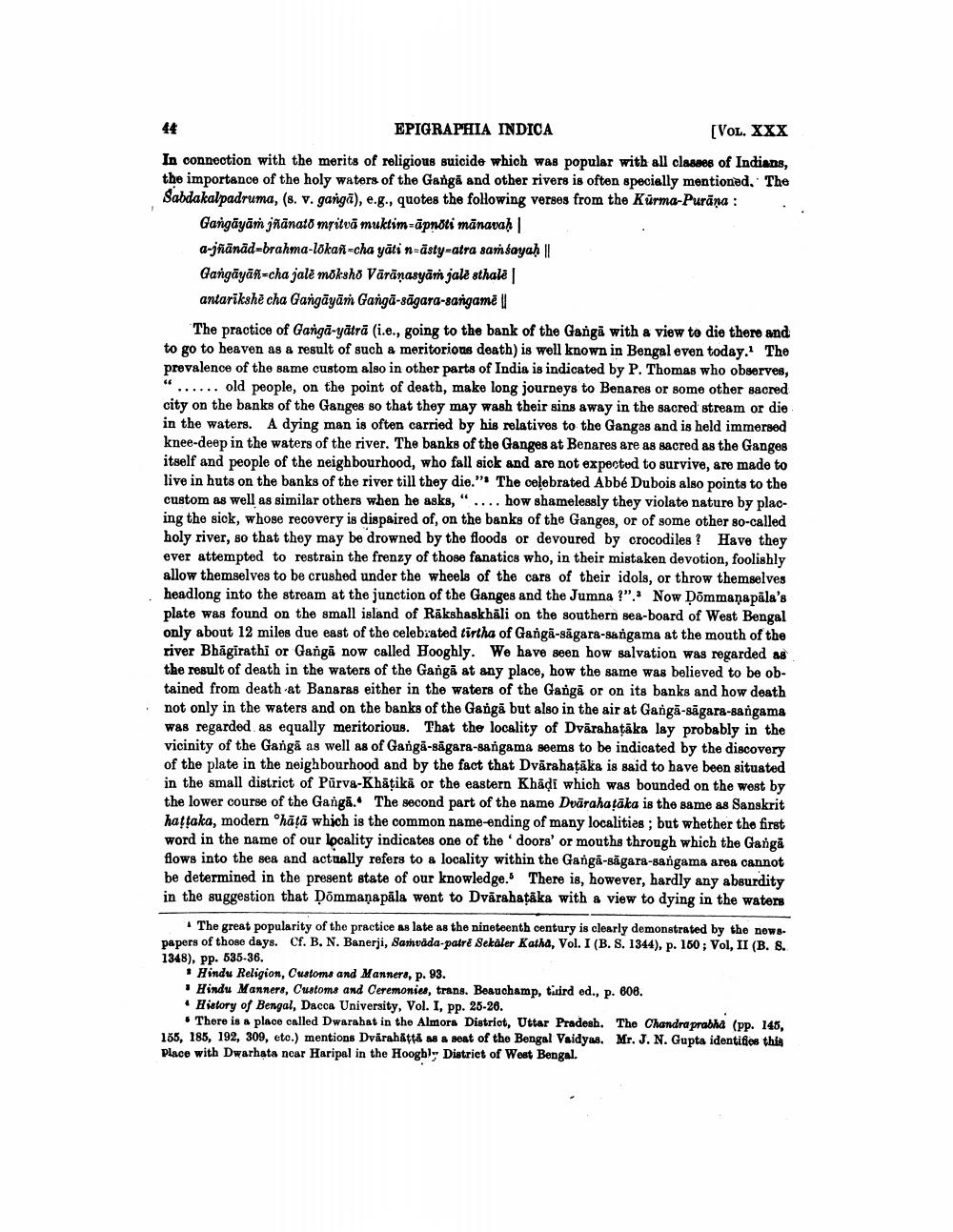________________
EPIGRAPHIA INDICA
[VOL. XXX In connection with the merits of religious suicide which was popular with all classes of Indians, the importance of the holy waters of the Gangā and other rivers is often specially mentioned. The Sabdakalpadruma, (8. v. gangā), e.g., quotes the following verses from the Kurma-Purāna :
Gangāyām jñānato mritvā muktim-āpnoti mānavah | a-jñānād=brahma-lokan-cha yāti n-ästy-atra sambayah || Gangāyāñ=cha jalė moksho Vārāṇasyāṁ jale sthale antarikshề cha Gangāyāṁ Ganga-sāgara-sangame ||
The practice of Gangā-yātrā (i.e., going to the bank of the Gangā with view to die there and to go to heaven as a result of such a meritorious death) is well known in Bengal even today. The prevalence of the same custom also in other parts of India is indicated by P. Thomas who observes, “...... old people, on the point of death, make long journeys to Benares or some other sacred city on the banks of the Ganges so that they may wash their sins away in the sacred stream or die in the waters. A dying man is often carried by his relatives to the Ganges and is held immersed knee-deep in the waters of the river. The banks of the Ganges at Benares are as sacred as the Ganges itself and people of the neighbourhood, who fall sick and are not expected to survive, are made to live in huts on the banks of the river till they die.” The celebrated Abbé Dubois also points to the custom as well as similar others when he asks, ".... how shamelessly they violate nature by placing the sick, whose recovery is dispaired of, on the banks of the Ganges, or of some other so-called holy river, so that they may be drowned by the floods or devoured by crocodiles? Have they ever attempted to restrain the frenzy of those fanatics who, in their mistaken devotion, foolishly allow themselves to be crushed under the wheels of the care of their idols, or throw themselves headlong into the stream at the junction of the Ganges and the Jumna ?". Now Dommana päla's plate was found on the small island of Rākshaskhäli on the southern sea-board of West Bengal only about 12 miles due east of the celebrated tirtha of Ganga-sågara-sangama at the mouth of the river Bhagirathi or Gangă now called Hooghly. We have seen how salvation was regarded as the result of death in the waters of the Gangā at any place, how the same was believed to be obtained from death-at Banaras either in the waters of the Gangā or on its banks and how death not only in the waters and on the banks of the Gargā but also in the air at Ganga-sāgara-sangama was regarded as equally meritorious. That the locality of Dvārahatāka lay probably in the vicinity of the Gangā as well as of Ganga-sāgara-sangama seems to be indicated by the discovery of the plate in the neighbourhood and by the fact that Dvārahatāka is said to have been situated in the small district of Pūrva-Khātikā or the eastern Khadi which was bounded on the west by the lower course of the Gangā.. The second part of the name Dvärahatāka is the same as Sanskrit hattaka, modern ohāgā which is the common name-ending of many localities; but whether the first word in the name of our locality indicates one of the doors' or mouths through which the Ganga flows into the sea and actually refers to a locality within the Ganga-sågara-sangama area cannot be determined in the present state of our knowledge. There is, however, hardly any absurdity in the suggestion that Dömmaņapāla went to Dvārahatāka with a view to dying in the waters
The great popularity of the practice as late as the nineteenth century is clearly demonstrated by the newspapers of those days. Cf. B. N. Banerji, Samvada-patrė Sekaler Katha, Vol. I (B. S. 1344), p. 150; Vol, II (B. 8. 1348), pp. 535-36.
Hindu Religion, Customs and Manners, p. 93.
Hindu Manners, Customs and Ceremonies, trans. Beauchamp, third ed., p. 608. • History of Bengal, Dacca University, Vol. I, pp. 25-26.
• There is a place called Dwarahat in the Almora District, Uttar Pradesh. The Chandraprabha (pp. 148, 185, 185, 192, 309, etc.) mentions Dvärahattå as a seat of the Bengal Vaidyas. Mr. J. N. Gupta identifies this place with Dwarhata near Haripal in the Hoogbly District of West Bengal.




